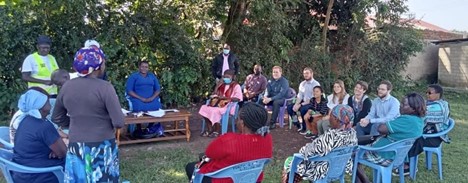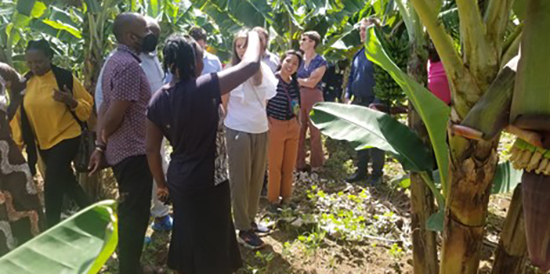Marissa Vander Missen is a rising second-year medical student at Indiana University (IU) School of Medicine. She is one of three Slemenda Scholars spending the summer in Eldoret, Kenya, with the AMPATH partnership.
We are now over one month into our summer as Slemenda Scholars, and it feels like the time in Eldoret and surrounding areas of Western Kenya has flown by. Feeling at home came easily, surrounded by enthusiastic team members at Moi Teaching and Referral Hospital (MTRH) and welcoming physicians and trainees at IU House–veterans and newbies alike.
We’ve had two impactful trips to visit AMPATH community groups. A recent trip to a women’s group called "Chama Cha mama totos” (or Chamas for short) reminded me of an earlier trip to Webuye which was one of the most influential experiences of my first week in Kenya.
Jeffrey Samuel is a health equity fellow in pharmacy who came to AMPATH Kenya through the involvement of the Purdue University School of Pharmacy. I have Jeffrey to thank for so many of the positive experiences during my first weeks in Kenya. His unbridled optimism about the power global partnership has to change communities, systems, and quality of life set the tone for my time as a Slemenda Scholar.
He was able to arrange for us to spend the day with BIGPIC project manager James Kamadi in Webuye, a town in Bungoma County, visiting the dozens of active BIGPIC/GISHE groups in their county. GISHE stands for Group Integrated Savings for Health and Empowerment, and these community groups incorporate microfinance and more. Bridging Income Generation with Group Integrated Care (BIGPIC) interventions overlay healthcare for chronic conditions in the GISHE group setting. BIGPIC is an AMPATH initiative created in response to the growing burden of cardiovascular disease and other associated chronic health conditions, such as diabetes and hypertension. BIGPIC worked within AMPATH’s existing Chronic Disease Management framework to deploy two evidence-based services (microfinance and group medical visits) in one setting, the GISHE group.
BIGPIC Project Manager James Kamadi is who some might call a “charismatic leader.” Kamadi’s advocacy for his county in connection with AMPATH, the Ministry of Health, and other organizations has transformed the health and access to care of his community. We started our visit to Webuye at the county hospital facility. In conversations I have learned that the Kenyan healthcare system has many levels for intervention including: the home and family, small nurse-run sites called dispensaries, sub-county hospitals, county hospitals, and tertiary referral hospitals like our home base, MTRH.
For a county hospital, Webuye’s seemed state-of-the-art. This may have something to do with Kamadi advocating for as many of his community members as possible to invest in the National Hospital Insurance Fund (NHIF), the national health insurance for Kenya. More patients in the county paying for national health insurance each month directly relates to the amount of government funds allocated to the county hospital. Some GISHE groups in Webuye County require that their members purchase NHIF monthly in order to be eligible for group membership, and anecdotally, these groups appear to be some of the most successful. GISHE group leaders and members throughout the county refer to Kamadi, as “daktari,” or doctor, even though he’s not a medical professional. Seeing the gratitude of an entire community for a leader bringing health to their backyards was powerful.
While the methodology behind BIGPIC and GISHE groups is inspiring itself, what is most inspiring is seeing the fruits of its success in action. Our first stop in Webuye was to a newly-formed GISHE group who was excited to welcome us into their meeting. There, we were able to discuss with some of the women about their livelihoods, families, and why they joined the group. Simultaneously, we observed as the clinical officer for Webuye’s groups, Phyllis, deftly conducted blood pressure and sugar checks for other group members on a small bench set up in the grassy field. Phyllis’s efficiency and compassionate care stood out to me; she’s somewhat of a one-woman show on the care-provision side of BIGPIC.
We then were able to visit two sites – a poultry-raising farm and another GISHE group – to see more of the microfinance in action. At the farm, we saw hundreds of healthy baby chicks being raised to be sold at a fair price to members of GISHE groups. The director of this poultry operation employs street youth and young people to help raise and sell the chickens out in the community, providing them a stipend for their services.
It felt like every level of the BIGPIC model thoughtfully added value into individual lives and the community as a whole.
Next, we visited a well-established GISHE group with over 30 members! Representatives from the Kenyan government’s Department of Agriculture were presenting at the meeting, helping with stewardship of a World Bank grant. The World Bank grant initiated this GISHE group’s dream of a banana plantation with an educational component; they have an experimental plantation on shared land and bring the best banana-farming practices back to their own homes to plant more trees. I was so touched to witness the pride and ownership as many different group members explained methods and shared success stories with us. This group exemplifies another facet of Kamadi’s excellent leadership. After GISHE groups are thriving, he connects them with outside organizations to link them with capital to kickstart opportunities like this educational, lucrative plantation.
On the way home from our visit to Webuye, fellow Slemenda Scholar Micaela Gaviola and I chatted with Jeffrey about the feasibility of translating the GISHE group or BIGPIC model to communities in need in the United States. We learned that microfinance and GISHE groups tapped into an important existing tradition in Kenyan communities. Kenyan women in many communities already gathered in small groups, sometimes informally doing community savings activities or supporting each other as peers. GISHE groups and BIGPIC took a strength and leveraged it toward increasing access to healthcare and income-generating opportunities.
While it may seem like similar support networks don’t exist in the US, Jeffrey made interesting parallels for Micaela and I to consider. He mentioned hypertension interventions that take place in barber shops (a place of community trust and connection) that have in many studies proven effective, (e.g. Victor RG, Ravenell JE, Freeman A, Bhat DG, Storm JS, Shafiq M, Knowles P, Hannan PJ, Haley R, Leonard D. A barber-based intervention for hypertension in African American men: design of a group randomized trial. Am Heart J. 2009 Jan;157(1):30-6. doi: 10.1016/j.ahj.2008.08.018. PMID: 19081393; PMCID: PMC2638989. ). It is exciting to push ourselves toward reciprocal innovation when we see successes of AMPATH and its community partners here in Kenya.
The visit to the Chama Cha mama toto group included all three Slemenda Scholars – Destiny Resner, Micaela and myself. We were able to visit a mother-child chama in Turbo, a small town in Uasin Gishu County. Doreen, a three-year employee of AMPATH who was born and raised in Eldoret, brought us to the Chama meeting and shared information about the groups with us throughout our visit. What was so special about this Chama visit was we got to see the community health volunteer run the group as she usually would, in Swahili and the local language. I felt even more welcomed into the group being able to experience how it usually runs and getting to focus more of my attention on the nonverbal ways the women interacted, visibly demonstrating trust and mutual respect. We saw all three portions of the Chama, including a lesson relevant to mothering (this week was empowering female children through education), a health lesson (this week was breastfeeding), and table-banking for microfinance.
Taken together, my experiences with GISHE groups and Chamas have left me inspired to seek out ways to integrate healthcare interventions with existing community support structures in Eldoret and back home in the US. I am excited to see what new learning opportunities and community experiences our final weeks hold!




